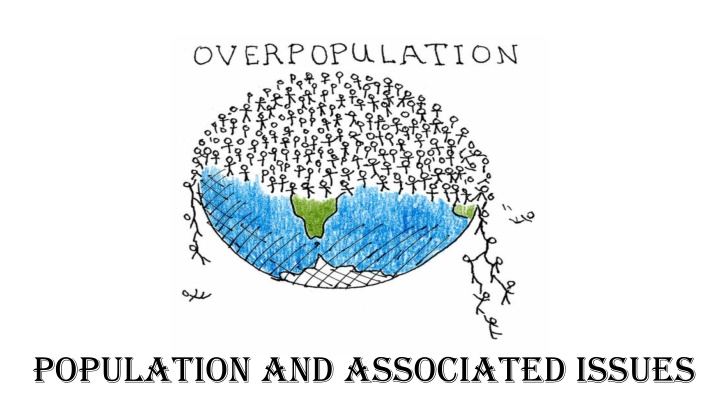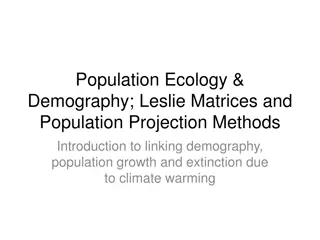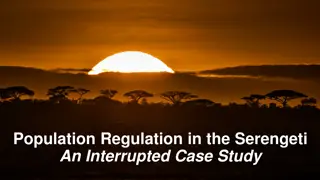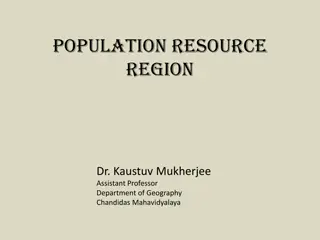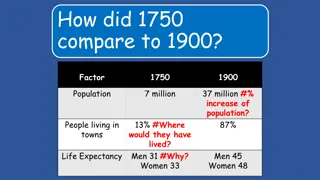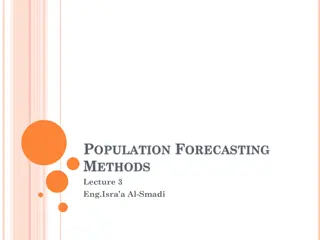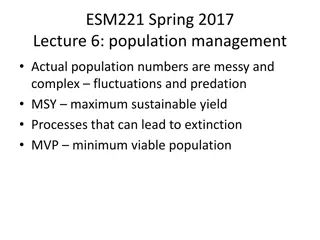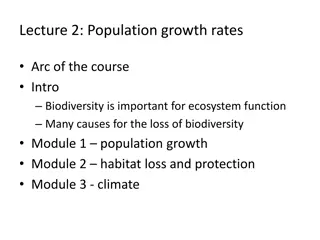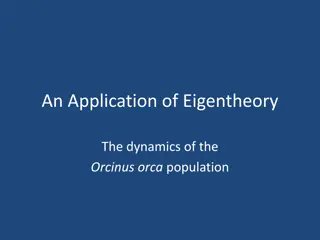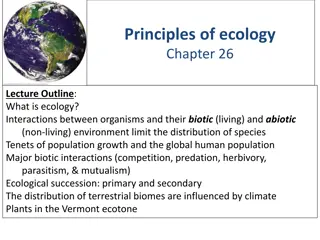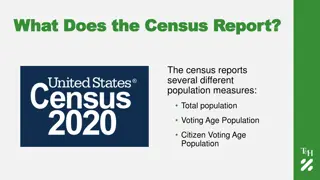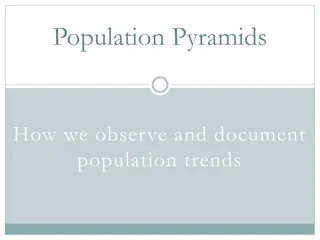Population Dynamics and Associated Factors
Demography, the systematic study of population, examines trends like population size changes, birth rates, deaths, and migration patterns. Understanding population density and distribution factors, such as geographical, socio-economic, political, and demographic aspects, is crucial in resource planning and policy-making. Various surveys like census and socio-economic studies provide insights into population trends and distribution. Factors like availability of water, economic activities, urbanization, and political conflicts play a significant role in shaping population distributions.
Download Presentation

Please find below an Image/Link to download the presentation.
The content on the website is provided AS IS for your information and personal use only. It may not be sold, licensed, or shared on other websites without obtaining consent from the author.If you encounter any issues during the download, it is possible that the publisher has removed the file from their server.
You are allowed to download the files provided on this website for personal or commercial use, subject to the condition that they are used lawfully. All files are the property of their respective owners.
The content on the website is provided AS IS for your information and personal use only. It may not be sold, licensed, or shared on other websites without obtaining consent from the author.
E N D
Presentation Transcript
Demography is the science of systematic study of population. Demography studies the trends and processes associated with population including changes in population size; patterns of births, deaths, and migration; and the structure and composition of the population, such as the relative proportions of women, men and different age groups.
How to Determine Population Trends? Census Survey The procedure of systematically acquiring and recording information about the members of a given population National Sample Survey Office (NSSO) in India is a unique setup to carry out surveys on socio-economic, demographic, agricultural and industrial subjects The decennial Census is conducted by the Office of the Registrar General and Census Commissioner, MHA Socio-Economic and Caste Census (SECC)
POPULATION DENSITY Population density refers to the total number of people per unit of area. It is dependent on the geographical location and geological factors. Assam, Himachal Pradesh, and other hilly terrains density of population. lower Northern plains and coastal areas like Kerala, West Bengal, and Maharashtra very high population density
FACTORS INFLUENCING THE DISTRIBUTION OF POPULATION POLITICAL FACTORS GEOGRAPHICAL FACTORS SOCIO-ECONOMIC FACTORS DEMOGRAPHIC FACTORS
GEOGRAPHICAL FACTORS Availability of water Soils Location of a place Land forms Climate Natural disasters
SOCIO-ECONOMIC FACTORS Minerals Economic activity Urbanization Industrialization Religious &cultural significance Transport Social Organization of communities
POLITICAL FACTORS DEMOGRAPHIC FACTORS War and political conflicts Migration Political unrest & discrimination Natural increase Policies
MALTHUSIAN THEORY OF POPULATION GROWTH Population Growth by a geometric progression (1, 2, 4, 8, and so on) Food production increases in arithmetic progression (1, 2, 3, 4, and so on) Results Disequilibrium between population & food supply How to correct Preventive Checks (late marriage, celibacy, family planning) Positive Checks (earthquake, epidemics, flood)
POPULATION COMPOSITION Adolescent Composition Age Composition Working population Composition Sex Composition Transgender Composition Literacy Composition Divyang Composition
POPULATION PYRAMID (THE AGE-SEX PYRAMID) The age-sex structure of a population refers to the number of females and males in different age groups. It is used to show the age-sex structure of the population. The shape of the population pyramid reflects the characteristics of the population. The shape of the population pyramid gradually evolves over time based on fertility, mortality, and international migration trends.
TRENDS IN GROWTH OF POPULATION Stable Population Period (1891-1921) Fast Growth of Population (1921-1951) Population Explosion (1951 1981) Population Declination ( post 1981)
DETERMINANTS OF POPULATION CHANGE FERTILITY MORTALITY MIGRATION
DETERMINANTS OF HIGH FERTILITY: Religious Ideologies Early marriage and early child-bearing. Preference for sons ingrained in Indian culture. Lack of the right of self-determination with reference to reproduction Economic, social, cultural as well as the religious value of children in the Indian society Absence of adoption of methods of conception control.
MORTALITY If the rate at which people die is more than the rate at which birth occurs, the number of people (population) will decrease and the reverse will occur if the death rate is lower than the birth rate. Three basic measures of mortality: crude death rate expectation of life at birth infant mortality rate Maternal Mortality Rate
MIGRATION migration is a form of geographical mobility or spatial mobility between one geographical unit and another, generally involving a change in residence from the place of origin or place of departure to the place of destination or place of arrival, for a considerable period of time Internal migration External migration migration from one place to another within a country migration from one country to another Immigration Emigration Migrants who move into a new place are called Immigrants Migrants who move out of a place are called Emigrants
In migration Out migration place of departure of the migrant migration into a particular area or area of destination movements out of a particular area or area of origin or long-range migration short-range/seasonal migration temporary work and residence for some or several months When a move is made for a longer period when people shift to the sites of permanent migration from one region to another when there is a permanent shift of population
Four stream of Internal migration Rural-Rural Urban- Urban Rural-Urban Urban-Rural
Factors responsible for migration Push Factor Pull Factor
THEORY OF DEMOGRAPHIC TRANSITION Theory throws light on changes in birth rate and death rate and consequently on the growth rate of the population. It is a generalized description of the changing pattern of mortality, fertility, and growth rates as societies move from one demographic regime to another.
Four stages to the classical demographic transition model: First Stage This stage has been called the high population growth potential stage It is characterized by high and fluctuating birth and death rates which will almost neutralize each other Second Stage It is called the stage of Population Explosion. death rate is decreasing while the birth rate remains constant at a high level Medical and health facilities are expanded
Third Stage birth rate as compared to the death rate declines more rapidly This stage witnesses a fall in the birth rate while the death rate stays constant Fourth Stage It is called the stage of the stationary population. Birth rate and death rate are both at a low level and they are again near balance
DEMOGRAPHIC DIVIDEND Demographic dividend occurs when the proportion of working people in the total population is high because this indicates that more people have the potential to be productive and contribute to the growth of the economy 63% of the population in India is in the age group of 15-59 years
